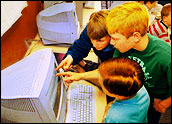
At this week’s Digital Life Design (DLD) conference in Germany, renowned scientists Craig Venter, Ph.D., and Richard Dawkins wowed the audience with a conversation about genes and information technology. They discussed how evolution is becoming man-made, which brings up a number of interesting issues.
“Genetics has become a branch of information technology,” Dawkins opined. There’s a good deal of evidence for his statement, including the announcement that Google-funded firm 23andMe launched its Web-based DNA (deoxyribonucleic acid) testing services in Europe this week. 23andMe is one of a number of firms that sample an individual’s DNA in order to offer clues to their genetically-driven future.
Increasingly, life is being translated into bits of code to be manipulated in the laboratory. Last year, for instance, Venter’s team transplanted the entire genome from one species of Mycoplasma bacteria into another. A few days later, the DNA from the first bacterium completely took over the second and became indistinguishable from the donating bacterium.
The March of Science
“When we look at cells as machines, it makes them very straightforward in the future to design them for very unique utilities,” Venter told participants at DLD. Of course, Venter has often referred to the possibility of designing cells to help clean the environment, but his premise could be applied for any purpose. Indeed, biogerontologist Aubrey de Grey is promoting the use of bio-engineering methods to repair human cells and fight aging. However, some worry that human-driven evolution could bring about harmful, unforeseen consequences.
“Accusing a scientist of playing God is obviously stupid,” Dawkins said, “but what is not obviously stupid is accusing a scientist of endangering the future of the planet by doing something that could be irreversible.”
He’s right about that, and that’s why a conversation about how scientists can safely create new life forms and alter existing ones has already begun in labs around the globe and at organizations like the Foresight Nanotech Institute. Indeed, most scientists are developing their work with an eye to improving the human lot, not the other way around.
There is no stopping the march of science, as some hope, including Sun Microsystems’ cofounder Bill Joy. Instead, the focus should be on the best practices created within the community itself. Plus, of course, technologies such as gene manipulation and nanotechnology are only pieces of the larger puzzle. Robotics is another.
Transferring Life
Partnering labs in North Carolina and Japan recently demonstrated that by implanting electrodes into the brain of a monkey, it is possible for a monkey to learn to make a robot walk just by thinking about it. That has incredible consequences not just for paralyzed individuals, but also for military and other applications. Then there’s organ-growing.
University of Minnesota researchers recently created a beating heart in the lab by injecting fresh heart cells into a non-living rat heart matrix. This follows on the heels of a technology dubbed “organ-printing” which has also created beating heart cells. However, innovation, Venter noted, may not be limited to the planet Earth.
“We can transfer life across the universe as digital information,” Venter explained. “Somebody else could, in their laboratory, build that genetic code and replicate it. Perhaps publishing my genome on the Internet had more applications than I thought.”
All these examples show that the future of human enhancement is rocketing forward, and many people from a variety of disciplines are contributing. Technology is the common driver, but in the end, is simply a tool. Tools can be used for good or evil purposes, and it’s up to involved and responsible people to make sure they use the technology and innovations in a beneficial way. There is reason to believe that enhancement technologies will be used for both good and evil purposes, but in an age of greater communication, globalization and transparency, the good should stand a better chance of winning.
Martians attempting to clone Venter aren’t likely to come along anytime soon, but a whole host of other innovations are on their way and are set to change the direction and pace of human evolution. Meanwhile, 2008 is the year when the public should start to notice that evolution itself is evolving.
Sonia Arrison, a TechNewsWorld columnist, is senior fellow in technology studies at the California-based Pacific Research Institute.





















































